Report names 7 least developed areas in Tanzania

The Prime Minister of state in the Prime Minister's Office (Investment and Empowerment).Mr Christopher Chiza ,speaks at a past event.
What you need to know:
The report, which was launched on Friday by the government, also identified seven regions with the high level of human development as Dar es Salaam, Arusha, Kilimanjaro, Iringa, Ruvuma, Mbeya and Tanga.
Dar es Salaam. Dodoma, Kigoma, Singida, Kagera, Tabora, Shinyanga and Coast regions have the least level of human development in Tanzania, a report has established.
The report, which was launched on Friday by the government, also identified seven regions with the high level of human development as Dar es Salaam, Arusha, Kilimanjaro, Iringa, Ruvuma, Mbeya and Tanga.
The indicators used to measure the human development level include life expectancy, which, among others, shows that the maximum life expectancy level is 83.6 years while the minimum level is 20 years.
Other indicators include expected years of schooling which is 13, access to clean and safe water, access to electricity, sanitation, nutrition, child mortality and level of gender development.
Other indicators include maternal mortality, environment, income, poverty level, level of freedom and access to basic needs such as food, water and housing.
Delivering his speech at the launching ceremony, the permanent secretary in the ministry of Finance, Dr Servacius Likwelile, said the Human Development Report was important for policy development.
He said the report’s theme ‘Economic Transformation for Human Development’, was in line with the national development vision of transforming the economy based on subsistence agriculture to highly productive economy based on vibrant industrial and services sectors.
He spoke of a decline in the share of agriculture in GDP and employment, rise in modern industrial and service economy, growth in urbanisation and demographic transition from high death and birth rates to low death and birth rates.
“The government is happy that the 2014 Human Development report addresses the relevant subject of human development,” said Dr Likwelile.
He commended the UN for the support and the Economic and Social Research Foundation (ESRF) for conducting the study on human development.
The UN resident coordinator and representative of the United Nations Development Programme, Mr Alvaro Rodgriguez, said the document was a critical tool for UN to support Tanzania to enlarge people’s choices through improving their capabilities, expanding their opportunities and removing cultural, social, political and economic barriers to development.
“In addition, the report provides us with an opportunity to discuss Tanzania’s development from human development perspective,” he said.
By emphasising the well-being of individuals, people are placed at the centre of development paradigm, according to him.
ESRF executive director Hoseana Lunogelo said the Tanzania Human Development report was homegrown, focusing on the system developed by the UN in publishing global human development reports on annual basis.
Dr Lunogelo listed other partners in preparing the report as the National Bureau of Statistics, the Office of the Chief Government Statistician of Zanzibar and the Department of Economics of the University of Dar es Salaam.
MORE INFO: SIGN OF ECONOMIC TRANSFORMATION
According the 2014 Tanzania Human Development report, agriculture as a share of total employment stood at 84.2 per cent in 1990/91 and rose slightly to 85.4 per cent in 2000/01, before falling to 76.5 per cent in 2006. This fall would seem to be a sign of Tanzania’s economic transformation moving in a positive direction in terms of labour entering higher productivity sectors.




